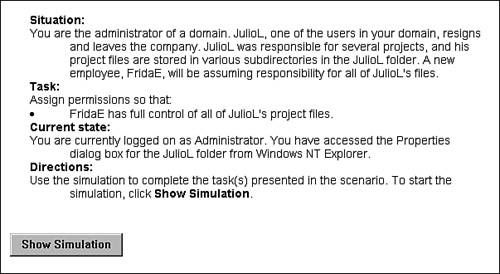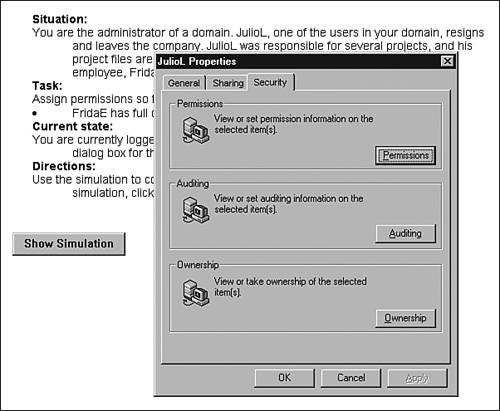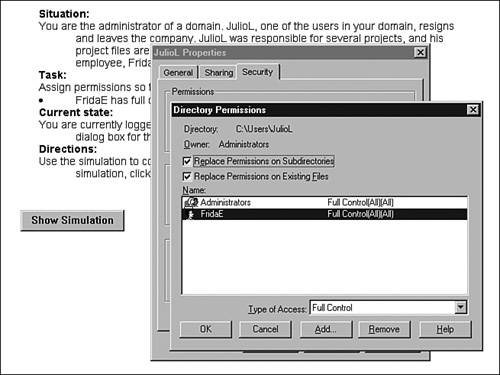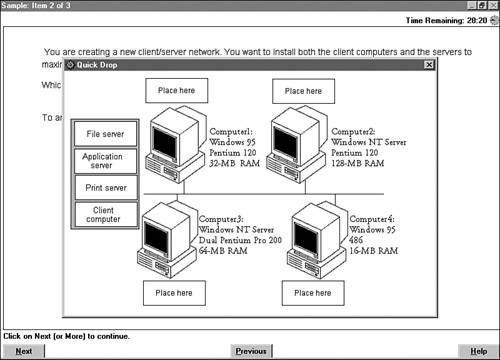Exam Prep Tips
| After you have mastered the subject matter, the final preparatory step is to understand how the exam will be presented. Make no mistake: A Microsoft Certified Professional (MCP) exam challenges both your knowledge and your test-taking skills. The following sections describe the basics of exam design and the exam formats, as well as provide hints targeted to each of the exam formats. Preparing for the 70-270 exam is a bit different than preparing for those old Microsoft exams, too. The following is a list of things that you should consider doing:
MCP Exam DesignEvery MCP exam is released in one of three basic formats. What's being called exam format here is really little more than a combination of the overall exam structure and the presentation method for exam questions. Understanding the exam formats is key to good preparation because the exam format determines the number of questions presented, the difficulty of those questions, and the amount of time allowed to complete the exam. All the exam formats use many of the same types of questions. These types or styles of questions include several types of traditional multiple-choice questions, multiple-rating (or scenario-based) questions, and simulation-based questions. Some exams include other types of questions that ask you to drag and drop objects onscreen, reorder a list, or categorize things. Still other exams ask you to answer various types of questions in response to case studies you have read. It's important that you understand the types of questions you will be asked and the actions required to answer them properly. The following sections address the exam formats and the question types. Understanding the formats and question types will help you feel much more comfortable when you take the exam. Exam FormatsAs mentioned previously, there are two basic formats for the MCP exams: the traditional fixed-form exam and the case study exam. As its name implies, the fixed-form exam presents a fixed set of questions during the exam session. The case study exam includes case studies organized into testlets that serve as the basis for answering the questions. Most MCP exams these days utilize the fixed-form approach, with the case study approach running second. Another test format previously used was the adaptive exam; however, Microsoft no longer employs adaptive algorithms in their exams. The adaptive exam uses only a subset of questions drawn from a larger pool during any given exam session. It may present each test-taker with a different number of questions, depending on how the person answers the initial questions. Fixed-Form ExamsA fixed-form computerized exam is based on a fixed set of exam questions. The individual questions are presented in random order during a test session. If you take the same exam more than once, you won't necessarily see exactly the same questions. This is because two or three final forms are typically assembled for every fixed-form exam Microsoft releases. These are usually labeled Forms A, B, and C. The final forms of a fixed-form exam are identical in terms of content coverage, number of questions, and allotted time, but the questions for each are different. However, some of the same questions are shared among different final forms. When questions are shared among multiple final forms of an exam, the percentage of sharing is generally small. Many final forms share no questions, but some older exams may have a 10%15% duplication of exam questions on the final exam forms. Fixed-form exams also have fixed time limits in which you must complete them. The score you achieve on a fixed-form exam, which is always calculated for MCP exams on a scale of 0 to 1,000, is based on the number of questions you answer correctly. The passing score is the same for all final forms of a given fixed-form exam. Although Microsoft no longer reports the actual score to you, preferring to just tell you whether you passed, it is still calculated in this fashion. The typical design of a fixed-form exam is as follows:
Case Study ExamsThe case studybased format for Microsoft exams first appeared with the advent of the 70-100 exam (the original "Solution Architectures" exam) and then appeared in the MCSE sequence in the Design exams. The questions in the case study format are not the independent entities that they are in the fixed-format exams. Instead, questions are tied to a case study, a long scenario-like description of an information technology situation. As the test-taker, your job is to extract from the case study the information that needs to be integrated with your understanding of Microsoft technology. The idea is that a case study will provide you with a situation that is even more like a real-life problem than the other formats provide. The case studies are presented as testlets. A testlet is a section within the exam in which you read the case study and then answer 10 to 20 questions that apply to the case study. When you finish that section, you move on to another testlet, with another case study and its associated questions. Typically, three to five of these testlets compose the overall exam. You are given more time to complete such an exam than to complete the other types because it takes time to read through the cases and analyze them. You might have as much as three hours to complete a case study examand you might need all of it. The case studies are always available through a linking button while you are in a testlet. However, when you leave a testlet, you cannot come back to it. Figure 1 provides an illustration of part of such a case study. Figure 1. An example of a case study. Question TypesA variety of question types can appear on MCP exams. We have attempted to cover all the types that are available at the time of this writing. Most of the question types discussed in the following sections can appear in each of the three exam formats. A typical MCP exam question is based on the idea of measuring skills or the ability to complete tasks. Therefore, most of the questions are written so as to present you with a situation that includes a role (such as a system administrator or technician), a technology environment (for example, 100 computers running Windows XP Professional on a Windows Server 2003 network), and a problem to be solved (for example, the user can connect to services on the LAN but not on the intranet). The answers indicate actions you might take to solve the problem or create setups or environments that would function correctly from the start. You should keep this in mind as you read the questions on the exam. You might encounter some questions that just call for you to regurgitate facts, but these will be relatively few and far between. The following sections look at the different question types. Multiple-Choice QuestionsDespite the variety of question types that now appear in various MCP exams, the multiple-choice question is still the basic building block of the exams. The multiple-choice question comes in three varieties:
Examples of multiple-choice questions appear at the end of each chapter in this book. Simulation QuestionsSimulation-based questions reproduce the look and feel of key Microsoft product features for the purpose of testing. The simulation software used in MCP exams has been designed to look and act, as much as possible, just like the actual product. Consequently, answering simulation questions in an MCP exam entails completing one or more tasks just as if you were using the product itself. A typical Microsoft simulation question consists of a brief scenario or problem statement, along with one or more tasks that you must complete to solve the problem. It sounds obvious, but your first step when you encounter a simulation question is to carefully read the question (see Figure 2). You should not go straight to the simulation application! You must assess the problem that's presented and identify the conditions that make up the problem scenario. You should note the tasks that must be performed or outcomes that must be achieved to answer the question, and then you should review any instructions you're given on how to proceed. Figure 2. A typical MCP exam simulation with directions. The next step is to launch the simulator by using the button provided. After you click the Show Simulation button, you see a feature of the product, as shown in the dialog box in Figure 3. The simulation application partially obscures the question text on many test center machines. You should feel free to reposition the simulator and to move between the question text screen and the simulator by using hotkeys or point-and-click navigationor even by clicking the simulator's launch button again. Figure 3. Launching the simulation application. It is important for you to understand that your answer to the simulation question is not recorded until you move on to the next exam question. This gives you the added capability of closing and reopening the simulation application (by using the launch button) on the same question without losing any partial answer you may have made. The third step is to use the simulator as you would the actual product to solve the problem or perform the defined tasks. Again, the simulation software is designed to functionwithin reasonjust as the product does. But you shouldn't expect the simulator to reproduce product behavior perfectly. Most importantly, you should not allow yourself to become flustered if the simulator does not look or act exactly like the product. Figure 4 shows the solution to the sample simulation problem. Figure 4. The solution to the simulation example. Two final points will help you tackle simulation questions. First, you should respond only to what is being asked in the question; you should not solve problems that you are not asked to solve. Second, you should accept what is being asked of you. You might not entirely agree with conditions in the problem statement, the quality of the desired solution, or the sufficiency of defined tasks to adequately solve the problem. However, you should remember that you are being tested on your ability to solve the problem as it is presented. The solution to the simulation problem shown in Figure 4 perfectly illustrates both those points. As you'll recall from the question scenario (refer to Figure 2), you were asked to assign appropriate permissions to a new user, FridaE. You were not instructed to make any other changes in permissions. Therefore, if you were to modify or remove the administrator's permissions, this item would be scored wrong on an MCP exam. Hot-Area QuestionHot-area questions Microsoft has utilized call for you to click a graphic or diagram to complete some task. You are asked a question that is similar to any other, but rather than click an option button or check box next to an answer, you click the relevant item in a screenshot or on a part of a diagram. An example of such an item is shown in Figure 5. Figure 5. A typical hot-area question. Drag-and-Drop Questionstwo different types of drag-and-drop questions in exams: select-and-place questions and drop-and-connect questions. Both are covered in the following sections. Select-and-Place QuestionsSelect-and-place questions typically require you to drag and drop labels on images in a diagram so as to correctly label or identify some portion of a network. Figure 6 shows you the actual question portion of a select-and-place item. Figure 6. A select-and-place question. Figure 7 shows the window you would see after you clicked Select and Place. It contains the actual diagram in which you would select and drag the various server roles and match them up with the appropriate computers. Figure 7. The window containing the select-and-place diagram. Drop-and-Connect QuestionsDrop-and-connect questions provide a different spin on drag-and-drop questions. This type of question provides you with the opportunity to create boxes that you can label, as well as connectors of various types with which to link them. In essence, you create a model or diagram to answer a drop-and-connect question. You might have to create a network diagram or a data model for a database system. Figure 8 illustrates the idea of a drop-and-connect question. Figure 8. A drop-and-connect question. Microsoft seems to be getting away from this type of question, perhaps because of the complexity involved. You might see the same sort of concepts tested with a more traditional question utilizing multiple exhibits, each of which shows a diagram; in this type of question, you must choose which exhibit correctly portrays the solution to the problem posed in the question. Ordered-List QuestionsOrdered-list questions require you to consider a list of items and place them in the proper order. You select items and then use a button or drag and drop to add them to a new list in the correct order. You can use another button to remove the items in the new order in case you change your mind and want to reorder things. Figure 9 shows an ordered-list question. Figure 9. An ordered-list question. Tree QuestionsTree questions require you to think hierarchically and categorically. You are asked to place items from a list into categories that are displayed as nodes in a tree structure. Such questions might ask you to identify parent-child relationships in processes or the structure of keys in a database. You might also be required to show order within the categories, much as you would in an ordered-list question. Figure 10 shows an example of a tree question. Figure 10. A tree question. Putting It All TogetherAs you can see, Microsoft is making an effort to utilize question types that go beyond asking you to simply memorize facts. These question types force you to know how to accomplish tasks and understand concepts and relationships. You should study so that you can answer these types of questions rather than those that simply ask you to recall facts. Given all the different pieces of information presented so far, the following sections present a set of tips that will help you successfully tackle the exam. More Exam-Preparation TipsGeneric exam-preparation advice is always useful. Tips include the following:
Tips for Success During the Exam SessionThe following generic exam-taking advice that you've heard for years applies when you're taking an MCP exam:
Besides considering the basic preparation and test-taking advice presented so far, you also need to consider the challenges presented by the different exam designs, as described in the following sections. Tips for Fixed-Form ExamsBecause a fixed-form exam is composed of a fixed, finite set of questions, you should add these tips to your strategy for taking a fixed-form exam:
Tips for Case Study ExamsThe case study exam format calls for unique study and exam-taking strategies:
|
EAN: 2147483647
Pages: 193